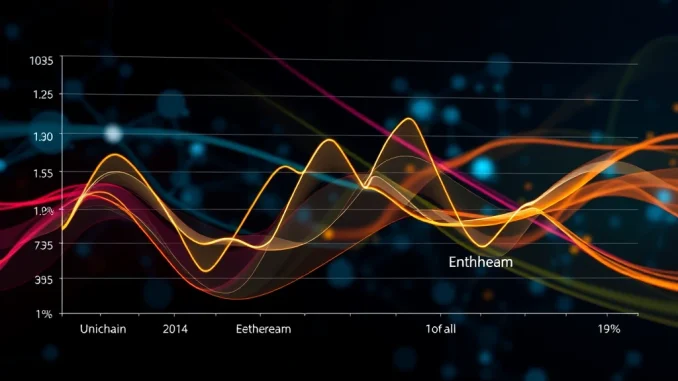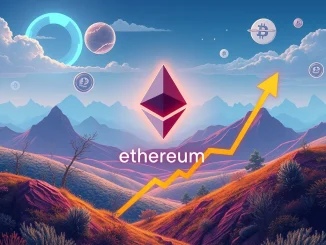
Big news is shaking up the world of decentralized finance (DeFi)! **Unichain**, the dedicated Layer-2 blockchain built specifically for Uniswap, has achieved a significant milestone. Reports indicate that Unichain has now surpassed the Ethereum mainnet itself in terms of raw **Uniswap v4** transaction volume. This isn’t just a small lead; data suggests Unichain is handling the vast majority of activity on the latest version of the popular decentralized exchange.
Unpacking the Data: Unichain Takes the Lead in Uniswap v4 Activity
According to a report from The Block, which cited data from analytics platform Dune Analytics, **Unichain** now accounts for a staggering share of transactions occurring on Uniswap v4. While Ethereum has historically been the bedrock for Uniswap, its share of v4 volume has reportedly dropped below 20%. In contrast, Unichain is currently handling approximately 75% of all activity on this specific version of the protocol.
This shift is notable because Uniswap is one of the largest and most influential decentralized exchanges in the DeFi space. The adoption of its dedicated Layer-2 for its newest iteration, Uniswap v4, highlights a growing trend in the industry: the move towards more scalable and cost-effective solutions.
Why is Unichain Surpassing Ethereum Transaction Volume?
The primary drivers behind users and activity migrating from Ethereum to a **Layer-2 blockchain** like Unichain boil down to the fundamental challenges faced by Ethereum’s mainnet:
- High Gas Fees: Performing transactions on Ethereum can become prohibitively expensive, especially during periods of network congestion. This makes frequent trading or smaller transactions impractical for many users.
- Slower Transaction Speeds: While secure, Ethereum’s transaction finality can be slower compared to optimized Layer-2 solutions designed for rapid throughput.
Unichain, as a Layer-2 rollup, processes transactions off the main Ethereum chain in a more efficient environment. These transactions are then bundled and submitted back to Ethereum for final settlement, inheriting Ethereum’s security while offering significantly lower fees and faster processing times. For active traders and liquidity providers on **Uniswap v4**, these efficiency gains are a major draw.
The Growing Influence of Layer-2 Blockchain Solutions in DeFi
Unichain’s rise in **Uniswap v4** volume is a clear indicator of the increasing importance of **Layer-2 blockchain** networks in the broader **DeFi** ecosystem. These scaling solutions are not just theoretical concepts anymore; they are actively capturing significant portions of network activity from the mainnet.
Beyond transaction volume, Unichain is also establishing itself in terms of locked value. According to data from DeFiLlama, Unichain’s total value locked (TVL) currently stands at approximately $800 million. This TVL figure positions Unichain as the third-largest Layer-2 rollup by this metric, demonstrating user and protocol confidence in its platform for holding significant capital.
This growth in both volume and TVL underscores the critical role Layer-2s play in enabling DeFi to scale beyond the limitations of Layer-1 networks like Ethereum, making decentralized applications more accessible and usable for a wider audience.
What Does This Shift Mean for the Future of DeFi?
This development holds several implications for the future of **DeFi** and the relationship between Layer-1s and Layer-2s:
- Layer-2 Dominance for Specific Apps: We may see more application-specific Layer-2s or general-purpose Layer-2s become the primary hubs of activity for major DeFi protocols, leaving the Layer-1 for settlement and security.
- Ethereum’s Evolving Role: Ethereum could increasingly function as a robust settlement layer and a base for security, while the bulk of user interaction and transaction volume happens on Layer-2s.
- Increased Competition Among L2s: As more activity shifts off-chain, the competition among various Layer-2 solutions (Optimistic Rollups, Zero-Knowledge Rollups, etc.) for users, developers, and TVL will intensify.
- Improved User Experience: The success of platforms like Unichain points to a future where DeFi is faster and cheaper, potentially onboarding more users who were previously deterred by high costs on Layer-1.
While Unichain’s rapid ascent in **Uniswap v4** volume is impressive, the DeFi landscape is dynamic. Factors like future Ethereum upgrades (Proto-Danksharding aimed at reducing L2 costs), the development of competing Layer-2 technologies, and changes in user behavior will continue to shape where activity flows.
Conclusion: Unichain’s Milestone Signals a Scaled Future for DeFi
The news that **Unichain** has surpassed **Ethereum transaction volume** on **Uniswap v4** is more than just a statistic; it’s a clear signal about the direction of decentralized finance. It highlights the critical need for scalability and the successful role that **Layer-2 blockchain** solutions are playing in meeting that demand. With a significant TVL and the lion’s share of volume on Uniswap’s newest iteration, Unichain is demonstrating the viability and necessity of dedicated scaling solutions for major DeFi protocols. As the ecosystem matures, expect Layer-2s like Unichain to continue playing a central role in making **DeFi** faster, cheaper, and more accessible to everyone.



